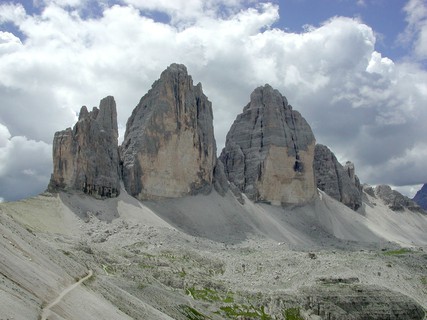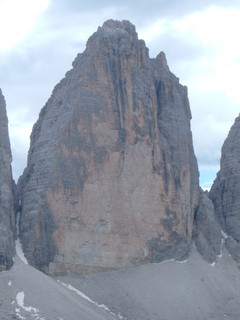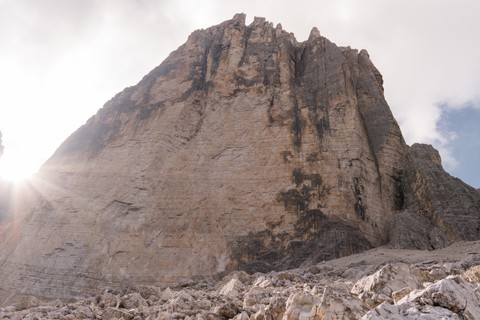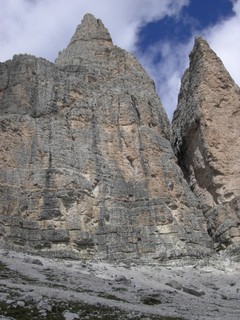A Crag Guide gives an extensive view of all sub areas and climbs at a point in the index. It shows a snapshot of the index heirachy, up to 300 climbs (or areas) on a single web page. It shows selected comments climbers have made on a recently submitted ascent.
At a minor crag level this should be suitable for printing and taking with you on a climbing trip as an adjunct to your guidebook.
This guide was generated anonymously. Login to show your logged ascents against each route.
Warning
Rock climbing is extremely dangerous and can result in serious injury or death. Users acting on any information directly or indirectly available from this site do so at their own risk.
This guide is compiled from a community of users and is presented without verification that the information is accurate or complete and is subject to system errors. By using this guide you acknowledge that the material described in this document is extremely dangerous, and that the content may be misleading or wrong. In particular there may be misdescriptions of routes, incorrectly drawn topo lines, incorrect difficulty ratings or incorrect or missing protection ratings. This includes both errors from the content and system errors.
Nobody has checked this particlular guide so you cannot rely on it's accuracy like you would a store bought guide.
You should not depend on any information gleaned from this guide for your personal safety.
You must keep this warning with the guide. For more information refer to our:
Usage policy
Contributors
Thanks to the following people who have contributed to this crag guide:
Kai
Radoslav Golian
Elmo
Zdenek Moravek
Tom
Campbell Gome
Felix Parham
www.gstörtetouren.at
FlorianW
Hans Dülfer †
The size of a person's name reflects their Crag Karma, which is their level of contribution. You can help contribute to your local crag by adding descriptions, photos, topos and more.
Table of contents
- 1.
Tre Cime di Lavaredo / Drei Zinnen
47 in Crag
- 1.1. Cima Ovest / Westliche Zinne 16 in Sector
-
1.2.
Cima Grande di Lavaredo / Cima Grande / Große Zinne 14 in Crag
- 1.2.1. Parete Nord 10 in Cliff
- 1.2.2. Parete Sud 4 in Cliff
-
1.3.
Cima Piccola / Kleinen Zinne 17 in Sector
- 1.3.1. Punta di Frida 5 in Sector
- 1.3.2. Torre Preuß / Kleinste Zinne / Preußturm / Cima Piccolisima 3 in Sector
- 2. Index by grade
1. Tre Cime di Lavaredo 47 routes in Crag
- Summary:
-
Mostly Trad climbing
Lat / Long: 46.619225, 12.299079
- Cima Piccola / Kleine Zinne ("little peak")
- Cima Grande / Große Zinne ("big peak")
- Cima Ovest / Westliche Zinne ("western peak").
- 1987 First free ascent of 'Hasse-Brandler' and 'Schweizer Führe' by Kurt Albert †
- 2001 First free ascent of 'Bellavista' by Alexander Huber
- 2007 First free ascent of 'Pan Aroma' by Alexander Huber
description
The Tre Cime di Lavaredo (Italian for "three peaks of Lavaredo"), also called the Drei Zinnen (German, literally "three merlons"), are three distinctive battlement-like peaks, in the Sexten Dolomites of northeastern Italy. They are probably one of the best-known mountain groups in the Alps. The three peaks, from east to west, are:
history
The first ascent of the Cima Grande was on August 21, 1869, by Paul Grohmann with guides Franz Innerkofler and Peter Salcher. The Cima Ovest was first climbed exactly ten years later, on August 21, 1879, by Michel Innerkofler with G. Ploner, a tourist. The Cima Piccola was first climbed on July 25, 1881, by Michel and Hans Innerkofler. The routes of these three first ascents are still the normal ascent routes; the Cima Piccola's route is the most difficult of the three.
Emilio Comici † was the first to climb the north face of the Cima Grande in 1933 in a party of three, after an ascent time of 3 days and 2 nights. This partly overhanging northern face is considered by climbers to be one of the great north faces of the Alps.
Other Milestones:
  |
1.1. Cima Ovest 16 routes in Sector
- Summary:
-
Trad climbing, Sport climbing and other styles
Lat / Long: 46.617605, 12.297065
description
DE: Westliche Zinne
| Route | Grade | Style | Selected ascents | |||
|---|---|---|---|---|---|---|
| 1 |
★★ Westwand / Dülfer
After a not so nice start in wet gullies the climb gives 5 fine pitches on pleasant rock before the scrambling of the summit pyramid begins Tourenbericht von Hans Dülfer: Westliche Zinne 2974 m. Erster Aufstieg über die Westwand. (Hans Dülfer und Werner Schaarschmidt am 29. Juli 2012.) Vom Paternsattel unter den Nordabstürzen der Drei Zinnen querend zur engen Schlucht zwischen Landroer Zinne und einer westlich von ihr herabstreichenden Felsrippe. In der Schlucht bis zu einem Schuttplatz oberhalb eines mächtigen Blockes, wobei ein überhängender Kamin über die Felsrippe rechts, die darauffolgende Schneerinne über die Wand links sehr schwierig umgangen werden können. Vom Schuttplatz links haltend, erst 30 m über eine schwierige plattige Wand, dann aufwärts zu einem langen, unter einer überhängenden Stufe ziehenden Bande, das bis zu seinem Ende nach links verfolgt wird. Rechts von dem hier ansetzenden schwarzen Riß sehr schwierig über die 8 m hohe Wandstufe empor; dann über die gutgegliederte Wand in einer Schleife rechts, oben einige Risse benutzend, aufwärts, bis man sich knapp unterhalb des auffallenden schwarzen Risses befindet. Hier in den Riß hinein und nach Erkletterung des sehr schwierigen Überhanges in ihm weiter, bis er, zu einer gelben Rinne erweitert, nach rechts umbiegt und auf einem Schuttplatz müdet. Nun nach rechts, erst eine angelehnte Platte überkletternd, dann auf brüchigem Bande - ein paar Schritte sehr schwierig und exponiert -, zuletzt ansteigend in den weiten und tiefeingeschnittenen Kamin hinein. Sein 15 m hoher Spalt, der hinter eingeklemmten Blöcken leichtes Durchkommen gewährt, leitet zu dem obersten, weniger steilen Teil der Westwand. Hier leichter aufwärts zu dem großen Schuttband unter der Gipfelwand und dem üblichen Wege zum höchsten Punkt. - Sehr schwierige und interessante Kletterei. Normale Dauer der Tur 3 Stunden. (Veröffentlicht im Jahresbericht 1912 der Alpenvereinsektion Bayerland) FA: W. Schaarschmidt & Hans Dülfer †, 1912 | {UIAA} 4+ | 450m | |||
| 2 |
★★ Normalweg
FA: M. Innerkofler & G. Ploner, 1879 | {UIAA} 3 | 600m | |||
| 3 |
★★ Demuthkante
FA: F. Demuth, S. Lichtenegger & F. Peringer, 1933 | {UIAA} 7 | 790m, 21 | |||
| 4 |
Petri Heil
Well protected with pitons and bolts, however some gear is needed: #0.4, #0.5, #0.75, #1 + 15 quickdraws. topo: https://www.bergsteigen.com/touren/klettern/petri-heil-westliche-zinne/ FA: Diddi Niederbrunner & Hannes Pfeifhofer, 2016 | 6c+ | 600m, 19 | |||
| 5 |
★★★ Schweizer Führe / Schweizerdach
FA: A. Schelbert & H. Weber, 1959 | {UIAA} 9- | 660m, 14 | |||
| 6 |
Bellavista
Starts right of Schweizerführe. Exit via Cassinführe. http://m.huberbuam.de/files/hb/content/topos/HB-Topo-Alps-Bellavista.pdf Set: Alexander Huber, 1999 FFA: Alexander Huber, 2001 | 8b+ | 280m, 10 | |||
| 7 |
Project Fear
Links the "Bauer Route", an old aid line, into the crux pitch of "Pan Aroma" and goes to the summit via the classic Cassin route. Initially graded 8c but downgraded by Siebe Vanhee to 8b+/8c in 2021. FFA: Dave MacLeod, 2014 Set: Dave MacLeod, 2014 | 8b+/c | ||||
| 8 |
Pan Aroma
http://m.huberbuam.de/files/hb/content/topos/HB-Topo-Alps-Pan-Aroma.pdf Initially graded 8c, but downgraded to 8b+ by Siebe vanHee later. FFA: Alexander Huber, 2007 | 8b+ | 500m, 11 | |||
| 9 |
★★★ Cassin, N.Face
FA: Vittorio Ratti & Riccardo Cassin, 1935 | A5+ | 450m | |||
| 10 |
Dülferkamin
Routenbeschreibung der Erstbegeher: Westliche Zinne 2974 m. Erste Durchkletterung des Südwandkamins: Walter F. v. Bernuth, Emil und Hans Dülfer am 13. August 1913. Vom Gipfelgrate der Westlichen Rinne zieht in die gelbe Südwand eine Depression hinab, die den Durchstieg vermittelt. Auf dem gewöhlichen Wege bis in die höhe der Scharte zwischen der Westlichen Zinne und ihrem südlichen Vorbauten, dann rechts durch einen Kamin auf ein breites Band. Auf ihm ein Stück nach rechts und etwas links der Fallinie der erwähnten Depression durch einen leichten Kamin auf ein zweites Band. Ein paar Meter nach recht und über eine brüchtige Stufe under einen mächtigen Überhang. Nun entweder äußerst schwierig durekt durch den stark überhängenden Riß hinauf und in dem flach anschließenden Kamin zu einem Absatz, - oder unter dem Überhang unschwer schräg rechts zu einem Riß, in ihm äußerst schwierig ein paar Meter aufwärts und in den Hauptkamin zurück. In ihrem oberen Teil verflacht sich die Depression zu einer Mulde, durch die man rechts haltend den Gipfel erreicht. (Veröffentlicht im Jahresbericht 1913 der Alpenvereinsektion Bayerland) FA: W. v. Bernuth, Emil Dülfer & Hans Dülfer †, 1913 | {UIAA} 4 | ||||
| 11 |
Via Couzy
FA: René Desmaison, Pierre Mazeaud, Pierre Kohlmann & Bernard Lagesse, 1959 FFA: Mauro Bole, 1999 | |||||
| 12 |
Alpenliebe
PDF Topo by Christoph Hainz FA: Christoph Hainz & Kurt Astner, 1996 | {UIAA} 9 | 600m, 17, 15 | |||
| 13 |
Via Baù-Migliorini-Tondini
Currently the route does not have a name and the first free ascent is still outstanding. FA: Claudio Migliorini, Alessandro Baù & Nicola Tondini, Sep 2019 | 14 | ||||
| 14 |
Space Vertigo
FFA: Alessandro Baù, Claudio Migliorini & Nicola Tondini, Sep 2020 | {UIAA} 9+/10- | ||||
| 15 |
★ Zinnfiziert
The route “Zinnfiziert” is on the south side of the Cima Ovest. The difficulty is VI + but in the 370m mostly in the range between V-VI. The route promises a beautiful alpine ascent on normal dolomite rock quality. 50 m-double rope, 8 quickdraws, Friends #0,4 #0,5 #0,75 #1 FA: Hannes Pfeifhofer & Diddi Niederbrunner, Jul 2020 | {UIAA} 6+ | 370m, 13 | |||
| 16 |
★ Skyline
Topo and description by Christoph Hainz FFA: Christoph Hainz & Gerda Schwienbacher, 29 Jun 2021 | {UIAA} 5+ | 1100m, 35 | |||
1.2. Cima Grande di Lavaredo 14 routes in Crag
- Summary:
-
Mostly Trad climbing
Lat / Long: 46.618291, 12.303394
1.2.1. Parete Nord 10 routes in Cliff
- Summary:
-
Mostly Trad climbing
Lat / Long: 46.619870, 12.303305
 |
||||||||
| Route | Grade | Style | Selected ascents | |||||
|---|---|---|---|---|---|---|---|---|
| 1 |
★★★ Spigolo Dibona / Dibona / Dibona Arete / Dibonakante
Spectacular climb at the Tre Cime di Lavaredo along the route to the Cima Grande di Lavaredo opened by the legendary Angelo Dibona. The itinerary of this great classic route climbs mostly along the northeast spur, overlooking at times in some sections the impressive north face of the Cima Grande. The route features a nice and well-paced climb up to the top of the tower at 2999 meters. FA: Rudl Eller, 1908 | {UIAA} 4+ | 640m | |||||
| 2 | Via Camillotto Pellesier | 8a+ | ||||||
| 3 |
★ Das Phantom der Zinne
FFA: Christoph Hainz & Kurt Astner, 1995 | {UIAA} 9+ | 550m, 17, 12 | |||||
| 4 |
★★★ Hasse-Brandler / Direttissima
Set: Dietrich Hasse, Lothar Brandler, Siegfried Löw & Jörg Lehne, 1958 | {UIAA} 8+ | 580m, 17 | |||||
| 5 | Sachsenweg / Superdirettissima | {UIAA} 5 A2 | ||||||
 |
||||||||
| Route | Grade | Style | Selected ascents | |||||
| 6 |
★★★ Comici-Dimai / Comici / North Face "Comici"
Cima Grande. Comici is popular doing the August holidays and can get crowded. September and October are also a good time to climb but it will be colder; the advantage is that you are likely to have the route to yourself - less risk of rock fall or being stuck behind a slow party. 8-12 hours ascent 2-3 hours descent Recommended gear: rack of nuts (1-10), a few small to medium cams, 16 draws, head torch, plenty of water and food, belay jackets. Start early - many people climb the first two pitches in the dark, arriving at the first crux pitch as it gets light. Helpful if you stay on route. Afternoon thunderstorms are dangerous. It is possible to retreat via abseiling during the first eight pitches, but after that, escape is much more difficult. FA: Giuseppe Dimai, Emilio Comici † & Angelo Dimai, 1933 | {UIAA} 7 | 540m, 17 | |||||
| 7 |
Das Erbe der Väter / The Heritage of our Fathers
http://www.simongietl.it/das-erbe-der-vaeter/ FFA: Simon Gietl & Vittorio Messini, Jul 2016 | {UIAA} 9- | 520m | |||||
| 8 |
★★★ Dülfer Dihedral / Dülfer Verschneidung
splendid crack line with crux at the top, just before reaching the SW-edge Tourbeschreibung von der Erstbegehung: Große Zinne 3003m Erste Aufstieg über die Westwand: Walter F. b. Bernuth und Hans Dülfer am 18. August 1913. Die westlichen Begrenzungskanten der Nord und Südwand flankieren eine verhältnismäßig schmale, von mächtigen überhängen durchzogene, senkrechte Wandflucht. Den Durchstieg durch diesen, über 200 Meter hohen, gelben Abbruch vermittelt eine etwa 150 Meter lange, rißdurchzogene Verschneidung, welche die Wand in ihrem südlichen Drittel bilden. - Von der westlichen Zinnenscharte nach links aufwärts und schließlich zu dem kleinen Schuttfeld unmittelbar unter dem senkrechten Wandabbruch der Verschneidung. Hier links zwischen einem Zacken und der Wand 5 Meter aufwärts; dann rechts steil 5 Meter hinan, bis man auf schmaler Leiste 4 Meter nach links querrend den Beginn eines gelben feinen Risses erreicht. Durch ihn senkrecht ungefähr 6 Meter hinauf zu einem Absatz. Rechts um eine abgesprengte Platte herum und über eine Rampe schräg rechts aufwärts zu einem kurzen Band. Oberhalb eines am Boden befindlichen Sicherungshakens äußerst schwierig über die 8 Meter hohe gelbe und senkrechte Wandstelle zu einem zweiten Band, das sich unmittelbar under dem Beginn der erwähnten Verschneidung befindet. In ihr mit Benutzung des Risses ungewöhnlich schwierig 12 Meter aufwärts unter einen kleinen Überhang der rechten Seitenwand. Über ihn hinweg und in der überhängenden Verschneidung weitere 12 Meter ungewöhnlich schwierig hinan unter einen Überhang der linken Seitenwand, der durch einen mächtigen, anscheinend losen Block gebildet wird. Noch 12 Meter äußerst schwierig aufwärts zu einem Stand (Sicherungshaken) oberhalb eines Klemmblockes. Höhe der in einem Stück zu durchkletternden, größtenteils überhängenden Stelle vom „zweiten Bande“ etwa 40 Meter. Nun etwas leichter 5 Meter aufwärts unter einem großen Überhang, äußerst schwierig über ihn hinweg und nach 6 Meter zu einem Stand (Sicherungshaken etwas höher). Ein ungefähr 10 Meter hoher Kamin leitet unter einen großen, schon von unten gut sichtbaren eingeklemmten Block. Durch ein enges Loch hinter ihm zu einem Geröllfeld unter der sich nun bedeutend erweiternden Fortsetzung des Kamins. In ihm an eingeklemmten Blöcken vorbei etwa 25 Meter spreizend aufwärts zu einem Absatz. In einem brüchigen Einriß links noch 6 Meter hinan zu einem Band. Etwas nach rechts und durch einen 15 Meter hohen Riß auf das nächsthöhere Band. Nun über einen Überhang hinauf und rechts durch eine Geröllrinne auf den Westgrad, über den man öfters rechts ausweichend den Gipfel erreicht. - Der lange Riß dürfte fast immer naß sein. Normale Zeit etwa 5 Stunden. Eine der schwersten uns bekannten Dolomittouren. (Veröffentlicht im Jahresbericht 1913 der Alpenvereinsektion Bayerland) FA: von Bernuth & Hans Dülfer †, 1913 | {UIAA} 5+ | 310m, 8 | |||||
| 9 |
Ohne Rauch stirbst du auch
FFA: Hannes Pfeifhofer & Daniel Rogger, 2010 | 8a | 480m, 17 | |||||
| 10 |
La Strada
FA: Piotr Edelman & Jan Fijalkowski, 1980 | {UIAA} 7+ A2 | ||||||
1.2.2. Parete Sud 4 routes in Cliff
- Summary:
-
All Trad climbing
Lat / Long: 46.617708, 12.303591
| Route | Grade | Style | Selected ascents | |||
|---|---|---|---|---|---|---|
| 1 |
★★★ Normal
im rechten Teil der Südseite Rinnen und Kamine, ab Ringband weiter links zum Gipfel FA: Paul Grohmann, Franz Innerkofler & Peter Salcher, 1869 | {UIAA} 3 | 450m | |||
| 2 |
★ "Dabistebaff"
Start 10 m right of the normal route, then up to a crack and chimney line, which ends at the ring ledge FA: Richard Goedeke, Herbert Konnerth & M. Zink, 1982 | {UIAA} 5 | 300m | |||
| 3 |
Via Grohmann - Hainz / Grohmann-Hainz Führe
Description and topo by Christoph Hainz at christoph-hainz.com Set: Christoph Hainz, Gerda Schwienbacher & CAI sezione di Auronzo, 2019 FA: Christoph Hainz & Gerda Schwienbacher, 8 Jun 2019 | UIAA:5- | 1100m, 47 | |||
| 4 |
★★★ Zeitsprung
Pitches 9 to 12 are a traverse right on the ledge. FA: Hannes Pfeifhofer & Dietmar Niederbrunner, Aug 2019 | 5+ | 460m, 17 | |||
1.3. Cima Piccola 17 routes in Sector
- Summary:
-
Mostly Trad climbing
Lat / Long: 46.619940, 12.307399
description
Die östliche der Drei Zinnen. Östlich der Kleinen Zinne sind von ihr noch Punta di Frida und Preußturm abgespalten.
approach
Vom Rifugio Lavaredo
descent notes
Abseil down the Normal Route to the shoulder, then straight down (W) into the gorge between Cima Grande and Cima Piccola (now equipped with good bolts)
| Route | Grade | Style | Selected ascents | |||
|---|---|---|---|---|---|---|
| 1 |
★★★ Normal Route
From the gorge between Cima Grande and Cima Piccola follow the obvious polished line to the shoulder and then climb the chimney (crux IV) to the top. Start of the first pitch is marked with a small white arrow and "Normal". Descent route by abseiling directly to the gorge (bolts) FA: Witzemnann & Michel und Hans Innerkofler, 1881 | {UIAA} 4 | 420m, 13 | |||
| 2 |
★★★ Noth Face
The left-hand chimney of the North Face FA: Sepp und Veit Innerkofler mit Hans Heversen, 1890 | {UIAA} 4+ | 250m | |||
| 3 |
★★★ N-Face Fehrmann-Smith
The right-hand crack of the north face FA: Rudolf Fehrmann & Oliver Perry Smith, 1909 | {UIAA} 5+ | 250m | |||
| 4 |
★★ Egger-Sauscheck (Vorgipfel Südwand)
Von links nach rechts schräg zur Kaminreihe der großen gelbweißen Wand links der Gelben Kante. Risse und Kamine direkt hinauf FA: Toni Egger H. Sauscheck, 1955 | {UIAA} 6+ | 320m | |||
| 5 |
★★★ Perlen vor die Säue
FFA: Kurt Albert † & Stefan Glowacz, 1996 | 9 | 280m, 9 | |||
| 6 |
★★★ Spigolo Giallo / Gelbe Kante / Yellow Edge
Pitch 10: You can climb straight up the corner, but don't make an anchor on the bad pitons at the end of the corner, traverse left and make the anchor on the ledge (pedestal). This variant is about 6+. FA: Renato Zanutti, Mary Varale & Emilio Comici †, 1933 | {UIAA} 6+ | 360m, 13 | |||
| 7 |
Nostalgie
Between 'Via Fehrman' and 'Spigolo Comici-Mazzorana'. FA: Manuel Baumgartner, 13 Jul 2019 | {UIAA} 8- | 240m, 8 | |||
| 10 |
Backstage
Nice apline multi pitch. FA: Vittorio Messini & Simon Gietl, 2019 | {UIAA} 8+ | 350m, 10 | |||
| 11 |
Ötzi trifft Yeti
FA: Christoph Hainz & Kurt Astner, 2001 | UIAA:8+ VII | 350m, 10, 12 | |||
1.3.1. Punta di Frida 5 routes in Sector
- Summary:
-
All Trad climbing
| Route | Grade | Style | Selected ascents | |||||
|---|---|---|---|---|---|---|---|---|
| 1 | Normalweg | 2 | ||||||
| 2 |
Via Dülfer
Einstieg am Beginn der Schlucht (Aneroid 2480 m). Der erste Abbruch wird in der Mitte, von rechts nach links ansteigend, überklettert. Unter der nächsten Steilstufe auf einem Kriechbande etwa 20m nach rechts schwierig mit Benutzung eines Risses auf das nächsthöhere Band und auf ihm, zuletzt kriechend, wieder in die Schlucht zurück. Ein paar Meter absteigen und, erst in der Ecke links, dann nach rechts querend, schwierig über den nächsten Abbruch. Weiter bis zu einer Höhle (2540 m), aus der man durch ein Loch oben links hinausgelangt. Nun leichter über Geröll und durch eine Kaminreihe rechts auf die Scharte (2600 m) zwischen Punta di Frida und Kleinster Zinne. Von der Scharte durch einen gelben Rill zuerst schwierig 25 m hinauf zu einem Felsköpfl in der Nordwand der Punta di Frida. Quergang 30 m nach rechts. (Durch die fortsetzung dies Querganges - zuerst auf das nächsttiefere Band absteigen - lassen sich die Schrofen unterhalb des Nordwandsattels gewinnen.) Nun auf ein 15m höher gelegenes Schuttband entweder gerade hinauf. über eine äußerst schwierige Wand oder bedeutend leichter durch eine große Schleife rechts, indem man erst 8 m absteigt. Schräg rechts (brüchig) ansteigend über eine schwierige Wandstelle in einen Kamin, den man knapp oberhalb seines ungangbaren Abbruches erreicht (2650 m). Im Kamin, der von der Hütte als feiner Stich sichtbar ist, über mehrere Überhänge aufwärts; nach 25 m exponierter und schwieriger Quergang etwa 10 m nach links, dann gerade hinauf zu einem kleinen Geröllfleck unter einem nach rechts ziehenden Spalt. Durch ihn auf ein kurzes Band (Steinmann) und noch 10 m schräg rechts aufwärts. Ein paar Meter unter einem auffallenden, aus einigen Blöcken gebildeten Bogen nach links zu einem Kamin, der auf leichteres Terrain leitet. Beliebig links zum Gipfel der Punta di Frida. Normale Dauer der Kletterei von der Scharte his zum Gipfel etwa 1 1/2 Stunden. Die Route ermöglicht eine vollständige Überschreitung des Massivs der Kleinen Zinne von Nordosten nach Südwesten: Kleinste Zinne (Nordostwand, Abstieg nach Südwesten zur Scharte) - Punta di Frida (Nordwand, Abstieg zum Nordwandsattel) - Kleine Zinne (Nordwand, Abstieg auf dem gewöhnlichen Wege). (Veröffentlicht im Jahresbericht 1912 der Alpenvereinsektion Bayerland) FA: Hans Dülfer †, Werner Schaarschmidt, G. B. Piaz, K. Jelinek & M. Michelsohn, 1912 | 4+ | ||||||
| 3 | Zelger | 4 | ||||||
| 4 |
The Lights from the other World
FA: Michal Coubal & Ája Coubalová, Jul 2018 | |||||||
 |
||||||||
| Route | Grade | Style | Selected ascents | |||||
| 5 |
★★★ Via Comici
In the center of the face. The crux is a slightly overhanging corner crack in the 4th pitch. Pitons in the route.
FA: E. Comici, G.B. Fabjan & V. Cottafavi, 1934 | {UIAA} 6- | 350m, 11 | |||||
1.3.2. Torre Preuß 3 routes in Sector
- Summary:
-
All Trad climbing
Lat / Long: 46.620794, 12.308937
| Route | Grade | Style | Selected ascents | |||
|---|---|---|---|---|---|---|
| 1 |
★★ Pruess Crack / Preuß Riss / Preuss-Riss
Descend: There is probably more options. I will describe how we did it:
Notes:
FA: Paul Preuß & P. Relly, 1911 | {UIAA} 5 | 240m, 8 | |||
| 2 |
★★★ Via Cassin
FA: Cassin, Vitali & Pozzi, 1934 | {UIAA} 7- | 340m, 12 | |||
| 3 | Via Nobile | 9+ | ||||

